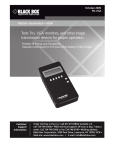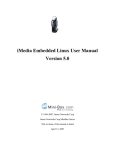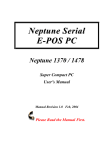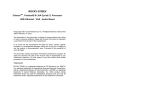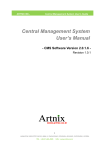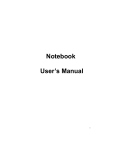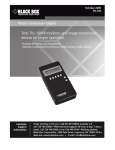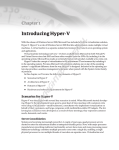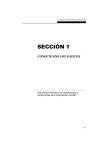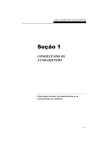Download 356S1 ch1 SE
Transcript
Section 1 GETTING TO KNOW THE BASICS SECTION 1 GETTING TO KNOW THE BASICS This section introduces the features and components of the notebook computer. 1-1 USER’S MANUAL Performance Features All-in-one Design The all-in-one design offers built-in floppy drive, hard disk drive, and optical drive (CD-ROM, CD-RW, or DVD-ROM) for the ultimate usability on the go. High Performance Processor The notebook is equipped with a powerful Intel Pentium 4 processor. The processor also supports the 400 MHz front side bus bandwidth for unparalleled performance. Advanced Graphic Engine An integrated AGP-bus 2D/3D video processor for high performance graphics. The integrated SiS650 graphic chip also incorporates an enhanced hardware-based motion-compensation engine which gives you smooth DVD video playback. Advanced 3D graphics capability offers the best realism to PC games. Expandability The system offers upgradeable hard disk drive and additional DDR RAM slot for expansion, all owing the user to easily increase the storage and system capacities as t he need arises. Large LCD Display The notebook is equipped with up to 15.1-inch TFT XGA display panel for clear text and brilliant colors. 1-2 Section 1 GETTING TO KNOW THE BASICS Audio Capability & S/PDIF Output The system is equipped with 4 speakers, which give you an added realism in sound. The audio playback function supports 3D audio, 64-voices DirectSound, and uses a hardware-based wave-table. The system is also equipped with a unique S/PDIF digital audio output for external AC3, DTS, or PCM decoding processor in your home audio-video system. Communication Features The system provides built-in Ethernet network adapter for local network and 56K modem for point to point connection or dial-up remote network. Firewire (IEEE1394) and USB ports In addition to a full array of built-in I/O ports, the notebook computer offers IEEE1394 for ultra high speed connection to high bandwidth digital video devices and USB ports for peripheral devices. Wireless LAN or Bluetooth (Optional) The optional internal Wireless LAN module or Bluetooth module allows your notebook to connect wirelessly to other 802.11b-enabled or Bluetooth systems, devices, or network. 1-3 USER’S MANUAL System at a Glance Top View 1-4 1. LCD Latch The LCD latches lock / unlock the LCD panel. 2. Built-in Microphone The built-in microphone records sound. Section 1 GETTING TO KNOW THE BASICS 3. LCD Display The panel is where the system content is displayed. 4. LED Status Indicators The LED Status indicators reveal the locking/unlocking of certain key functions and HDD/CD-ROM/FDD drive status. 5. Keyboard The enhanced 87/ 88-key keyboard is used to enter data. It has an embedded numeric keypad and cursor control keys. (See Keyboard Section for details.) 6. Power Status LED The multi-color LED indicates the power status of the notebook. (See the LED Status Indicator Section for details.) 7. Suspend LED Flashing green light indicates the notebook is in suspend mode. (See the LED Status Indicator Section for details.) 8a. Built-in Speakers (Front) The built-in speakers output the sound in stereo. 8b. Built-in Speakers (Rear) The built-in speakers output the sound in stereo. 9. Touch Pad with Page Up / Down Function The touch pad is a built-in pointing device with functions similar to a mouse. Use the Page Up or Down key to move one page up or down in Windows. 10. Stereo Headphone Jack The stereo headphone jack (3.5-mm diameter) is where you connect the headphones or external speakers. 11. Microphone Jack The microphone jack (3.5-mm diameter) is where you connect a microphone. 1-5 USER’S MANUAL 12. Firewire / IEEE1394 Port This is a high-speed data port. You may connect any Fire-wire-ready device to this port. 13. USB Port (x1) The Universal Serial Bus (USB) port allows you to connect a wide variety of devices via the USB cable to your notebook at very high data transfer rates of up to 12 Mbps. This port conforms to USB plug-and-play standards. Note: For the system running the Windows NT platform, USB function is not supported. 14. PC Card Slot (Type II PCMCIA) and Card Eject Button The slot is where PC Card (Type II PCMCIA) is inserted. Press the eject button to release the PC Card. 15. Audio Volume Dial Use the volume dial to control the loudness of the speakers. 16. CD-ROM (or DVD-ROM or CD-RW or Combo) Drive and Disk Eject Button and manual eject key hole If your notebook comes with DVD-ROM / Combo drive, you may play DVD movies or regular CD-ROM disk. If it comes with CD-RW / Combo drive, you may save data onto a CD-R / CD-RW disk. Press the eject button to eject the disk tray. The manual eject keyhole allows you to manually eject a jammed disk. 17. Modem Port This is where you plug the phone jack (RJ-11) for fax/modem functions. 18. Ethernet / LAN Port The port connects to a network hub via the RJ-45 cable and also conforms to 10/100Base-TX transmission protocol. 19. USB Port (x2) The Universal Serial Bus (USB) port allows you to connect a wide variety of devices via the USB cable to your notebook at very high data transfer rates of up to 12 Mbps. This port conforms to USB plug-and-play standards. 1-6 Section 1 GETTING TO KNOW THE BASICS 20. Power / Suspend Button The power/suspend button turns the notebook on and off and it also acts as a system suspend key. Press momentarily to turn on the system. Press and hold for at least 3~4 seconds to turn off the system. How this key behaves can be defined in [Start > Settings > Control Panel > Power Options > Advanced] menu. Press the power / suspend button again to return from the suspend mode. Note: To enable the Internet Hot Key, Email Hot Key, Search Key, and My Favorite Hot Key in Windows O/S other than XP /2000, you must install the special Quick Keys application contained in the factory CD-ROM (d:\Utility \ Qkeys \SETUP.EXE). Be sure you already have setup an ISP account and MS Internet Explore. 21. Internet Hot Key The `Internet Hot Key` launches the Internet Explore automatically in Windows XP or 2000. In other Windows O/S, you will need to activate a utility program in the factory CD to make use of the key. (See side-note for Quick Keys installation.) 22. Email Hot Key The `Email Hot Key` launches the MS Outlook Express in Windows XP or 2000. In other Windows O/S, you will need to activate a utility program in the factory CD to make use of the key. (See side-note for Quick Keys installation.) 23. My Favorite Hot Key The `My Favorite Hot Key` launches any Windows application you designate in the QuickKey application dialogue box. You will need to activate a utility program in the factory CD to make use of the key. (See side-note for Quick Keys installation.) 24. Ventilation Grill The fan grill is where air is drawn to dissipate the internal heat. Do not block this airway completely. 1-7 USER’S MANUAL Rear View Warning: Do not place any heavy objects on the top of notebook. That may damage the display. 1-8 1. Floppy Disk Drive and Disk Eject Button This drive is where the floppy disk is read and written. Press the ejection button to eject the floppy disk. 2. Ventilation Grill The fan grill is where hot air is vented. Do not block this airway completely. 3. S/PDIF Port The special optical port carries digital audio signal. You may connect an external DTS, AC3, or PCM sound processor/ decoder to this port. 4. Power Jack (DC-in) The DC-out jack of the AC Adapter connects here and powers the notebook. 5. Kensington Lock Key Hole A Kensington-type security lock latches to this key-hole for anti-theft purpose. Section 1 GETTING TO KNOW THE BASICS 6. Ventilation Grill The fan grill is where hot air is vented. Do not block this airway completely. 7. External VGA Port The 15-pin VGA analog port is for connecting the external CRT monitor or projector. 8. TV (S-Video) Port The S-Video port permits you to redirect the screen output to a television set or any analog video playback device. This TV Port is Macrovision-compliant; when DVD movie is played, the output is scrambled to prevent analog recording. 9. Infrared Port Infrared Data Association (IrDA) compliant serial infrared port enables 4Mbps (FIR mode) cable less data transfer with IrDA 1.1-compatible external devices. 1-9 USER’S MANUAL Bottom View 1-10 1. Ventilation Grills The grills are where air is exchanged in and out of the notebook for internal thermal regulation. Do not block the air-way completely. 2. Hard Disk Drive Bay This is where the hard disk drive is located. The hard disk drive stores all the system data. The hard disk drive can be upgraded to a larger capacity. 3. Battery Pack and Battery Latch The battery pack is a built-in power source for the notebook. Pull on the battery latch to release the battery pack. Section 1 GETTING TO KNOW THE BASICS 4. Floppy Disk Drive and Disk Eject Button The standard floppy disk drive can read and write the floppy disk. Press the Disk Eject Button to eject the diskette. AC Adapter 1. DC-out Connector The DC-out connector docks to the power jack (DC-in) on the notebook. 2. LED Lamp The LED lamp appears green when the unit is plugged into a valid AC source. 3. Adapter The adapter converts alternating current into constant DC voltage for the notebook. 4. AC Plug The AC plug plugs to the AC wall outlet. 1-11 USER’S MANUAL LED Status Indicators The LED Status Indicator displays the operating status of your notebook. When a certain function is enabled, an LED will light up. The following section describes its indication. System Indicators LED Graphic Symbol Indication Green light indicates the hard drive is being accessed. Green light indicates the floppy drive and/or CD-ROM drive is being accessed. Green light indicates the numeric keypad is activated. Green light indicates the cap-lock is activated. Green light indicates the scroll-lock is activated. Power Indicators LED Graphic Symbol Indication Blinking orange light indicates the battery is being charged (the system is OFF.) Blinking orange light indicates the battery is being charged (the system is ON.) Blinking green light indicates the battery power is currently low. Blinking green light indicates the notebook is in suspend mode. 1-12 Section 1 GETTING TO KNOW THE BASICS Keyboard Features Function (Hot) Keys Graphic Symbol Note: For various system controls, press the Fn (Function) key and the Fx key simultaneously. Action System Control Fn + F1 Enters Suspend Mode. Fn + F3 Turns Battery Warning Beep on or off. Fn + F4 Changes Display Mode: LCD-only, CRT-only and LCD&CRT. Fn + F5 Turns Speaker Volume up. Fn + F6 Turns Speaker Volume down. Fn + F7 Increases Display Brightness. Fn + F8 Decreases Display Brightness. Num Lock Enables the embedded keypad to work in numeric mode. The keys act like numeric keypads in a calculator. Use this mode when you need to do a lot of numeric data entry. An alternative would be to connect an external numeric keypad. Scroll Lock Press the ScrLk key and then press ↑or ↓ to move one line up or down. 1-13 USER’S MANUAL Windows Keys Your keyboard also has two Windows keys: 1. Start Key This key allows you to pull up the Windows Start Menu at the bottom of the taskbar. 2. Application Menu Key This key brings up the popup menu for the application, similar to a click of the right mouse button. Embedded Numeric Key Pad Press NumLock to enable the embedded numeric key pad. The numbers are printed in upper right corner of a key, in a color different from the alphabets. This key pad is complete with arithmetic operators (+, -, * , /). Press Fn+NumLock to revert to normal character keys. 1-14 Section 1 GETTING TO KNOW THE BASICS Touch Pad (Glide Pad) with Page Up / Page Down Function The built-in touch pad, which is a PS/2-compatible pointing device, senses movement on its surface. As you move your fingertip on the surface of the pad, the cursor responds accordingly. The following items teach you how to use the touch pad: 1. Move your finger across the touch pad to move the cursor. 2. Press buttons to select or execute functions. These two buttons are similar to the left and right buttons on a mouse. Tapping on the touch pad twice produces is similar to clicking the left button of a mouse. 3. Press Page Up / Down button to move up or down a page. Function Left Button Execution Click twice quickly Selection Click once Tap once Drag Click and hold to drag the cursor Tap twice quickly and on the second tap hold finger to the touch pad to drag the cursor Access Context Menu Move One Page Up or Down Right Button Page Up / Down Button Equivalent Tapping Action Tap twice (at the same speed as double-clicking the mouse button) Click once Click upper portion to move up a page Click lower portion to move down Tips on Using the Touch Pad: 1. The double-click speed is timed. If you double-click too slowly, your notebook responds as if you single-clicked twice. 2. Keep your fingers dry and clean when using the touch pad. Also keep the surface of touch pad clean and dry to prolong its life. 3. The touch pad is sensitive to finger movements. Hence, the lighter the touch, the better the response. Heavy touch does not produce better response. 1-15 USER’S MANUAL Display Your notebook uses a high performance 14.1-inch, or 15.1-inch active matrix TFT panel which supports high resolution and multimillion colors for comfortable viewing. Adjusting the Display Brightness Note: To maximize your battery operating time, set the brightness to the lowest comfortable setting, so that the internal back-light uses less power. The notebook uses special key combinations, called hot keys, to control brightness. Press Fn+F7 to increase the brightness. Press Fn+F8 to decrease the brightness. Extending the Life of the TFT Display Device Observe the following guidelines to maximize the life of the backlight in the display. 1. 2. 3. 4. 1-16 Set the brightness to the lowest comfortable setting (Fn+F8). When working at your desk, connect your notebook to an external monitor and disable the internal display Fn+ F4. Do not disable the suspend time-outs. If you are using AC power and have no external monitor attached, change to suspend mode when not in use. Section 1 GETTING TO KNOW THE BASICS Graphic Controller This notebook comes with an integrated AGP-bus SiS650 video graphics accelerator based on a share memory architecture (i.e. a portion of the system memory is allocated for graphic engine’s use.) Depending on the total system memory installed, up to 64MB can be allocated as graphic frame buffer. More memory to the graphic subsystem means higher graphic performance; however, as it decreases system memory capacity, overall system performance may suffer. Multimonitor Support The notebook’s display and multimedia capabilities are great for giving presentations. If you prefer, you can also connect an external monitor when giving presentations. This notebook supports LCD and CRT displays in Mirror mode or Multimonitor Mode. In the Mirror mode, both displays show the same content. In the Multimonitor mode, the system allows you to open and work on different applications independently across two display devices (i.e. the built-in LCD display and external display.) To enable Multimonitor function, do the following: Warning: To avoid damaging the display, do not slam it when closing. Do not place any object on top of the computer when the display is closed. Connect an external CRT or projector to the notebook first and restart the system. After boot-up, right-click the SiS icon on the task tray. Select Display Property and then Display Setting. You will see the Driver Mode Setting dialogue box. In the Driver Mode pull-down menu, select Multimonitor. The system will then ask you to reboot for the function to take place. Opening and Closing the Display Panel To open the display, slide the LCD latch to the right and lift up the lid. Then tilt it to a comfortable viewing position. To close the display cover, fold it down gently until the LCD latches click into place. 1-17 USER’S MANUAL Audio Devices Your notebook’s Audio is Sound Blaster Pro-compatible. Adjusting the Volume Manually To increase the volume, press Fn+ F5. To decrease the volume, press Fn+F6. Adjusting the Volume in Windows 1. 2. 3. Click the speaker symbol in the taskbar in Windows. Drag the volume control bar up or down to adjust the volume. To temporarily silence the speaker without changing the volume setting, click Mute. Adjusting the Speaker Volume Using the Volume Dial Rotate the Volume Dial (located to the left side of the notebook) to adjust the speaker volume. Voice Recording You need to use audio processing software to enable the built-in microphone. For example, you may use Microsoft Sound Recorder. When you begin voice recording using the notebook’s built-in microphone, be sure that your mouth is within near distance (no longer than 20 cm) to the microphone. If the record level is too small, you may also increase the microphone gain via the volume control panel in Windows. 1-18 Section 1 GETTING TO KNOW THE BASICS How to Enable S/PDIF Output Your notebook is equipped with an optical digital audio output port called S/PDIF. You will need to connect the output port to an external DTS, AC3, or PCM audio processor in your home audio system via an optical digital audio cable. To Enable S/PDIF output, do the following: Note: The S/PDIF port is located on the right side of the notebook. When you enable this port, all other audio functions will not work. There will be no sound from the speakers. 1. Double-click the speaker (audio) icon at the right hand corner of the task bar. 2. The following box will appear. Put a check on S/PDIF Output Enable to enable S/PDIF output port. 1-19 USER’S MANUAL Modem Your notebook comes with a 56K V.90 internal fax/modem and a phone jack (RJ-11), which is located on the left side of your notebook computer. Use a telephone cable to connect the notebook to the telephone wall outlet. Note: Some Windows versions do not support fax function. To enable this function, please install a fax communication software on your PC. Connecting the Modem 1. Plug one end of the phone line into the modem port located on the right side of the notebook. 2. Plug the other end of the line into the analog phone wall outlet. Modem Setting Depending on where your computer is used, you may need to change settings in the modem. Correct setting will allow you to maintain a stable connection in a country where its telecommunication system may be different to others. To change the modem setting, do the following: 1. Go to [Start > Settings > Control Panel] and double-click on Modem Settings icon. You will see a similar dialog box. 2. Click on the pull-down menu and select the country where it is applicable. Click on OK to exit. Warning: The internal modem is intended for use on an analog phone line, also called a POTS (Plain Old Telephone Service) line. This modem cannot be connected directly to a digital telephone line, such as those commonly found in a business office. You may either obtain an analog line or an analog converter compatible with the phone line you’re using. 1-20 Section 1 GETTING TO KNOW THE BASICS Network Adapter Your notebook is equipped with a 10/100Base-TX SiS900 PCI Fast Ethernet network adapter. Connect the active LAN cable to the RJ-45 LAN port located on the left side of the notebook. This allows you to access and transmit data in the local area network. Connecting to the Network Use Unshielded Twisted Pair (UTP) Ethernet cable only. 1. Insert one end of the UTP cable into the network connector until the connector snaps securely into the receptacle. 2. Either connect the other end of the cable to an RJ-45 jack wall outlet or to an RJ-45 port on a UTP concentrator or hub in the network. Cabling Restriction for Networks The following restrictions should be observed for 100BASE-TX networks: The maximum cable run length is 100 meters (m) (328 feet [ft]). For 100-Mbps operation, use Category 5 wiring and connections. Consult Windows manual and / or Novell Netware user‘s guide for the software installation, configuration, operation of the network. 1-21 USER’S MANUAL Wireless LAN (802.11b) Configuration (Optional Device) If your notebook comes with an optional Wireless LAN card, you may use the following as a simple guide to using the wireless function. To show the signal quality meter, do the following: Double tap the Wireless icon on the Taskbar and select Link Info tab. Note: Make sure the Wireless LAN driver is properly installed before using. Be sure to run the SETUP.EXE program in Wireless LAN subdirectory in the factory CD-ROM. 1-22 Section 1 GETTING TO KNOW THE BASICS To configure the Wireless LAN function, do the following: Double tap the Wireless icon on the Taskbar and select Configuration tab. Mode: SSID: Tx Rate: PS Mode: Channel: Select 802.11 AdHoc Mode Enter the same name if two or more than two system are to establish wireless connection. Select Fully Automatic for transmission rate Select Disabled Depending on your region or location, you may enter a specific value. For example, for North America, you may select channel 1 through 11. Go to [Start > Programs > PRISM 802.11 > Country Domain Selection] for a list of suitable channel for a particular region. 1-23

























